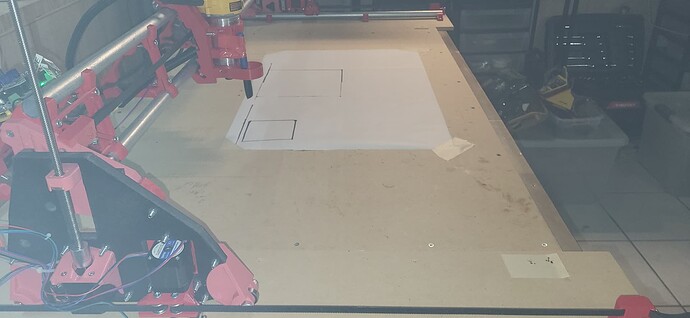Machine is built and ready to cut struts, but my x is far longer than my y making this problematic. Any ideas? Maybe cutting sections and laminating them?
With a tape measure, saw and drill, you could cut some plain rectangular struts. They wouldn’t have the fancy triangular cutouts, but they would work just as good (or better).
Alternatively, if you have some extra conduit and belt material, you could move everything to a bigger (longer) table temporarily.
If the your Y is long enough maybe you could cut them diagonal?
I would definitely have them cut in one piece, for rigidity sake.
This would work, but if all 3 sides have completely closed strut plates, dealing with the non-captured nuts on the inside can be difficult
We had a thread somewhere where I talked about doing the first part, then rotating the board and doing the second half (I cut my plates on my Primo before building the LR). With pegs it is pretty easy to line up.
If I understand the geometry right, the struts keep the long bar from bending into each axis, and provide some torsional rigidity as well. The strength is due to their minimal bend along the plane. But does it really matter if they don’t go all the way to the endplates? It seems to me they would work just the same if they were two inches shorter at each end (ie you cut them to the max length you could cleanly cut) and attached them to the second bracket in instead of the first. Someone who understands the mechanics better would need to confirm that.
One issue I can think of is that I think the two outermost supports are printed denser than the rest of them, so you might wind up swapping those a bit closer in.
Not really, as long as you install the non-captured struts first.
“can be”… of course on the initial install, it’s not as bad. If you, for some reason, need to remove the back one, etc, it gets worse. Not saying it’s impossible, just more difficult than if you have finger holes
Anything you change from the intended design can affect the performance/rigidity of the machine.
I’ve not seen anyone else operate like that, so it’s unlikely anyone can give you a real answer as to “how much” it affects it.
The answer, as always will likely be, “it depends”…
Are you planning to cut foam only? Mill aluminum? It’s possible that the ultimate rigidity might not matter if you decide you want to cut them short and operate that way depending on your intended use case.
That’s something that likely only you will be able to answer as to whether it’s “good enough”.
If it were me, I would choose one of the 3 available options mentioned above to make sure they were cut the proper length. Rigidity is already one of our big limiting factors with these machines
- Use a table saw to cut a proper length rectangle and manually drill the holes and mount them as @Bartman suggested
- Cut it on the diagonal. This is what is usually offered here as a solution, but has the drawback that you will be cutting near the center without struts, so you’ll want to take it pretty slow. Perhaps a temporary shorter strut across the center might help firm it up some? I’m not sure.
- Use registration dowels or some similar tiling method like @Tokoloshe suggested to be able to cut longer stock than your Y axis. I’ve never tried, but it is a common way to tackle this. It just takes a little extra prep ahead of time to make sure it’s done correctly
These answers are the reason I ask questions late at night rather than diving head first into the cement. It looks like I’ll be able to diagonal these in one shot. All day on the x and y axis one forgets you can use them both at the same time.
Looking forward to final assembly. Debating if I should go ahead and print Dan’s revised struts with all capture nuts now, or whenever I get infuriated with it later.
Thanks for the suggestions.
A little dab of epoxy when you install the nuts will work also, or maybe even better. (Just don’t epoxy the threads).
I found that the capture nuts were still a problem, in that the nuts would push out of the capture recess when removing the screw (screw would push the nut out unless you held the screw away from the brace as you turned the screw).
I made a remix of the braces that had all nuts captured. Then, I also glued the nuts in. I still had issues, in which the nuts would break free from both the PLA and the epoxy, and spin free. This was not on initial install, but rather on subsequent work.
I think I now lean toward a remix with threaded inserts (heat-serts).
Oops, I said Dan, but meant Doug as it is your remix I was think about. Given your comment, I think I’ll take the advice and use what I have for now and order inserts. The struts are, by far, the most expletive inducing part of the build for me. Thanks for the correction.
I also went for some time without grasping the reasons Ryan had for not putting captured nut slots on all sides. His logic is pretty sound. If the struts are installed in the correct order, you have access to the nuts for all but the last one. That one side where the stock brace has captured nuts, is the one side where the strut should be installed last! Makes sense.
Once you get a LowRider built, you will want to start cutting. It makes sense for the first cuts to be simpler cuts in a thin, fairly soft material that does not cost much. You can afford to mess up, while learning. This is exactly what strut cuts in hardboard are! Easy approach into CNC cutting.
So you can do section by section. Create by using the screw holes as reference.

